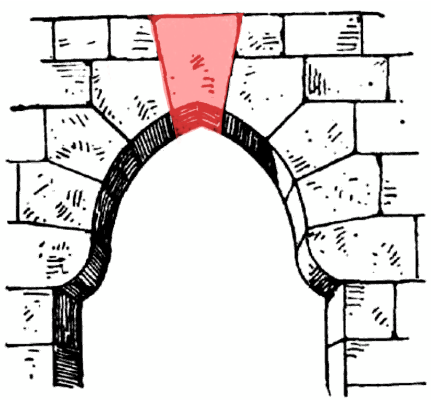The Keystone is one of Masonic teaching’s most beautiful emblems as a sign of completion. The Keystone is the final stone that must be placed to complete the arch’s construction. This unusually formed stone is a feat of engineering that is vital to the arch’s stability.
The Keystone sign is not seen in Lodge symbolism, however it does occur in Chapter degrees. In the unfolding of the symbolic legend of Hiram, the builder of the Keystone, it appears in the York Rite of Masonic degrees in Freemasonry.
The Keystone is a significant symbol in Freemasonry, embodying deep allegorical meaning and reflecting the rich heritage of the craft and its connection to the ancient stonemasons’ guilds. This emblem is particularly associated with the Royal Arch chapter of Freemasonry, one of the additional degrees that members can pursue beyond the initial three degrees of Entered Apprentice, Fellowcraft, and Master Mason.
The Keystone’s origins, symbolism, and place within Masonic ritual offer insights into the philosophical and ethical framework of Freemasonry.
Historical and Architectural Origins
The keystone is an architectural term referring to the central, wedge-shaped stone in an arch that locks all other stones into position, allowing the arch to bear weight. This piece is crucial in the construction and stability of arches, serving both a functional and symbolic role in architecture. In ancient times, the keystone was often elaborately decorated, highlighting its importance in the structure.

In the context of Freemasonry, the Keystone symbol draws directly from this architectural principle, symbolizing unity, strength, and the importance of each member in the fraternity. It serves as a metaphor for the critical role that each individual plays in the support and stability of the lodge and the broader Masonic community.
Symbolic Meanings in Freemasonry
Within the Royal Arch degree of Freemasonry, the Keystone takes on additional layers of meaning. It is often inscribed with certain characters or marks that are significant within Masonic lore, representing themes such as divine wisdom, strength, and beauty. The Keystone is considered a symbol of completion, representing the culmination of one’s journey through the initial degrees of Freemasonry and the mastery of certain moral and philosophical lessons.
The Royal Arch Degree
The Royal Arch is seen as the completion of the “Master Mason” degree, the third and initially highest degree in the symbolic lodge. The Royal Arch Masons meet in a chapter, distinct from the blue lodge, and the Keystone plays a central role in the chapter’s teachings and rituals. The degree tells a story related to the rebuilding of Solomon’s Temple, with the Keystone symbolizing the discovery of lost knowledge or the recovery of that which was thought to be lost forever.
Masonic Education and Moral Lessons
The Keystone, within the Royal Arch degree, teaches Masons about the importance of knowledge, unity, and the individual’s role in the collective strength of the organization. It encourages members to continue their Masonic education, striving for personal improvement and understanding. The emblem serves as a reminder that each Mason is a critical component in the larger structure of the fraternity, with a unique role and responsibility.
Conclusion
The Keystone is more than just an architectural term adopted by Freemasonry; it is a profound symbol of the craft’s core values and teachings. It represents the achievement of knowledge, the significance of unity and strength, and the individual’s journey towards becoming a keystone in their own right—integral to the support and stability of their community.
Through its use in ritual and its place in Masonic symbolism, the Keystone continues to inspire and instruct members of the fraternity, linking them to both the practical skills of the ancient stonemasons and the philosophical underpinnings of the Masonic tradition.

